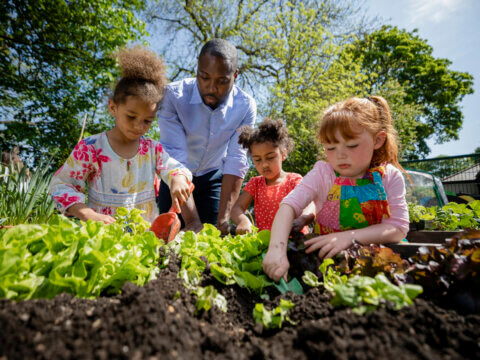TRENDS THAT GIVE US HOPE: The Power and Potential of Green Schoolyards
Second of two articles. Click here to read part one.
C&NN supports getting children outside and moving. That can take place in various environments: green schoolyards and gardens; traditional playgrounds, play structures and playing fields; private yards and wild places. No one size fits all. Incorporating natural elements into new or existing play spaces can give an extra boost to children’s physical health, psychological well-being, and their ability to learn. In the second of two articles, environmental planner Sharon Gamson Dank shares her views on how to do that. — Richard Louv
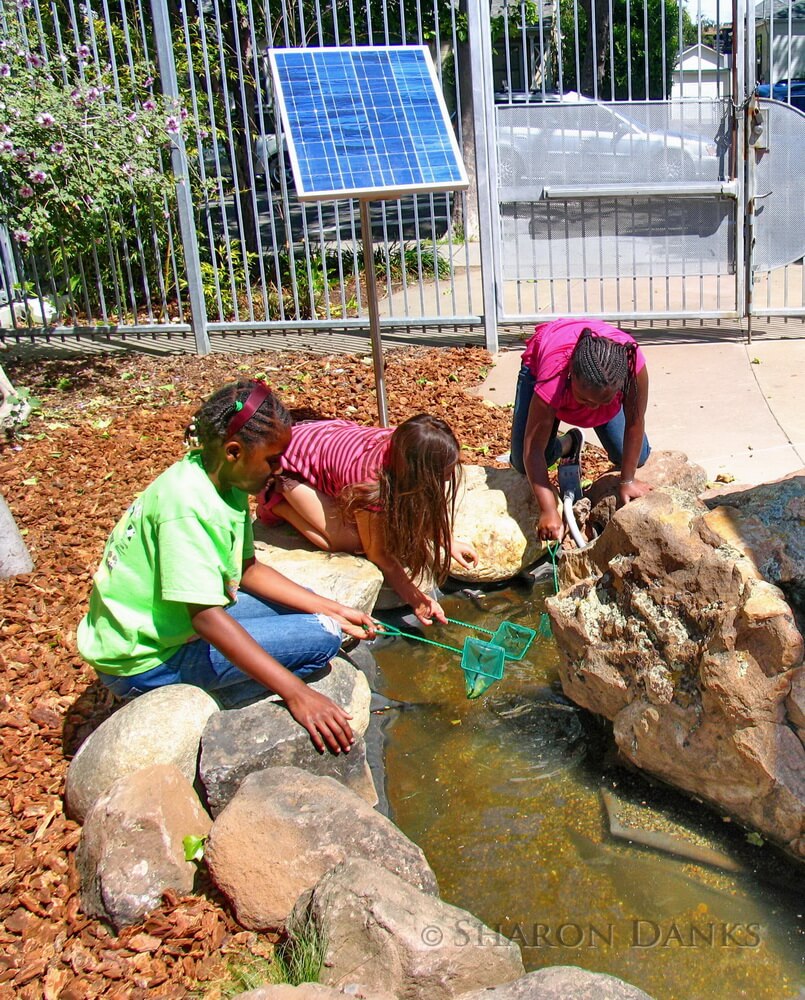 Public school districts are one of the largest landowners in almost every city and town across the United States and around the world. In the United States alone, over 132,0001 schools in more than 13,000 school districts serve more than 50 million pre-kindergarten to 12th grade students each year.2
Public school districts are one of the largest landowners in almost every city and town across the United States and around the world. In the United States alone, over 132,0001 schools in more than 13,000 school districts serve more than 50 million pre-kindergarten to 12th grade students each year.2
Choices made by school districts about how they manage their landscapes profoundly impact their city and generations of local residents whose perspectives are shaped through daily, outdoor experiences at school.
A movement to green school grounds and connect students to nature is gaining momentum in the United States and around the globe, weaving the ideas of urban sustainability and ecological design together with academic achievement, public health, children’s wellbeing, sense of place, and community engagement.
Green schoolyards bring nature back to cities and suburbs by transforming barren asphalt and ordinary grass into vibrant environments for learning and play, set within the context of the rich, local ecosystems that nurture wildlife and the natural processes that underlie and sustain our urban infrastructure. Green schoolyards foster children’s social, physical, and intellectual growth and health by providing settings for curiosity, collaboration, imagination, exploration, adventure, and wonder.
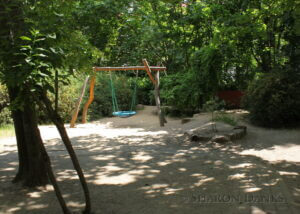 If, as a society, we can turn our attention and resources toward creating school district-wide, ecological systems-based improvements to school grounds, we will make significant progress in addressing complex inter-related problems. Large scale schoolyard greening efforts, if implemented across our cities, have the potential to provide:
If, as a society, we can turn our attention and resources toward creating school district-wide, ecological systems-based improvements to school grounds, we will make significant progress in addressing complex inter-related problems. Large scale schoolyard greening efforts, if implemented across our cities, have the potential to provide:
ACCESS TO NATURE
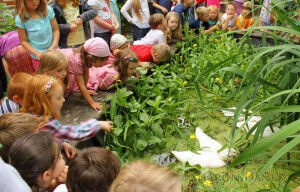 Daily Nature Access – If green schoolyards can be built at every school, they will provide every child in every city with high quality access to nearby nature on a daily basis—democratizing nature access across socio-economic , racial and cultural lines.
Daily Nature Access – If green schoolyards can be built at every school, they will provide every child in every city with high quality access to nearby nature on a daily basis—democratizing nature access across socio-economic , racial and cultural lines.- Balance – Hands-on, daily access to nature on school grounds helps to balance real-world, sensory experiences with our increasingly digital world.
- Sense of Place – Green schoolyards, built with local, natural materials and native plants, are each unique, reflecting the geography, ecology, and culture of their community and building a sense of place for children and adults who spend time in them.
ECOLOGICAL INFRASTRUCTURE REPAIR
 Water – School grounds designed to manage stormwater can be beautiful and educational while containing and conserving rainwater and purifying urban runoff.
Water – School grounds designed to manage stormwater can be beautiful and educational while containing and conserving rainwater and purifying urban runoff.- Habitat – Schoolyard landscapes planted with native vegetation can complement local habitat conservation plans and add many additional acres to support wildlife.
- Climate – Trees and shrubs can be placed to provide shade for children and school buildings, reducing sun exposure, urban heat island effects, and interior cooling costs for school buildings.
- Energy – School grounds can host renewable energy demonstration systems that power decorative fountains—or the school—teaching children and their communities about clean energy.
- Materials – Landscape features designed using sustainable, natural and recycled building materials demonstrate green building practices and reduce a school district’s impact on landfills and other urban infrastructure.
IMPROVED TEACHING AND LEARNING ENVIRONMENTS
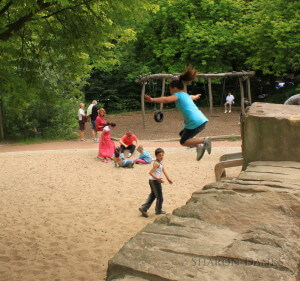 Educational Attainment – Studies show that many children learn better with hands-on experiences in the types of outdoor settings green schoolyards afford.3
Educational Attainment – Studies show that many children learn better with hands-on experiences in the types of outdoor settings green schoolyards afford.3- Improved Teacher Satisfaction – Outdoor teaching environments are also appreciated by teachers who benefit from abundant teaching resources, conveniently located near their classrooms, and the variety and diversity of experiences found in outside.
- Reduced Bullying – Green schoolyards promote imaginative play and provide variety and diversity in children’s social and play environments, reducing boredom, shifting social leadership structures, and leading to fewer disciplinary problems such as playground bullying.4
HEALTH AND WELLBEING
- Obesity Prevention – Green schoolyard environments that provide opportunities for exploration and imagination offer child-driven, play-based solutions to the obesity epidemic.
- Healthier Lifestyles – Green schoolyards promote healthier lifestyles through increased physical activity and nutrition-oriented gardening and cooking programs. They are also settings for learning new skills that foster lifelong health, from balance to water safety and tool use.
- Improved Wellbeing – Green spaces of all types have therapeutic properties that lower our blood pressure, help us relax and provide other benefits that improve wellbeing of children, teachers, school administrators and visitors.
COMMUNITY ENGAGEMENT
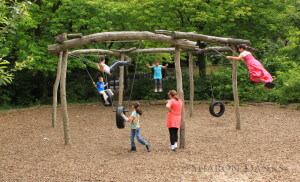 Empowerment – Green schoolyards are places where children of all ages can gain experience repairing their own local ecosystems and make a difference in our world. They are places where collaborative environmental action leads to clear, positive results that counter Ecophobia and build our confidence in the power of working together—sending messages of optimism and hope to children and adults alike.
Empowerment – Green schoolyards are places where children of all ages can gain experience repairing their own local ecosystems and make a difference in our world. They are places where collaborative environmental action leads to clear, positive results that counter Ecophobia and build our confidence in the power of working together—sending messages of optimism and hope to children and adults alike.- Stewardship – By transforming the idea of schoolyard “maintenance” into the broader concept of “stewardship”, school communities can become partners with their school districts and collaborate to reduce management costs while fostering increased parent involvement and community building.
Green schoolyards are a central piece of a wider vision to restore our relationship with the natural world. The time is right to invest much more significantly in our school grounds across the country. The green schoolyard movement has the power to bring nature to every child, every day while improving our local ecosystems, learning environments, and health.
Small scale green schoolyard projects now exist around the U.S., showing incredible promise but generally lacking the larger scale investments that can help them to reach their full potential.
This is a call to scale up our green schoolyard work from coast to coast, and empower school districts to lead this paradigm shift with increased support from their communities, public institutions, local utilities, healthcare institutions and other like-minded organizations and partners.
Combining our resources in one place—school grounds—will multiply benefits for our cities and our children in the years to come. Is it hard? Yes, but we know where to start and together we can change our course.
- National Center for Education Statistics, “Digest of Education Statistics,” “Table 5: Number of educational institutions, by level and control of institution: Selected years, 1980-81 through 2010-11.”
- National Center for Education Statistics, “Fast Facts”
- Children & Nature Network, “Children’s Contact with the Outdoors and Nature: A Focus on Educators and Educational Settings,” 2010.
- Louv, Richard, keynote presentation for the San Francisco Green Schoolyard Alliance’s Growing Greener School Grounds Conference. San Francisco, CA (October 10, 2008).
-
Feature
GROWING POWER: Urban Roots connects young people with natural spaces, food systems – and one another
-
Feature
Nature photographer Dudley Edmondson has a vision for the representation of Black and Brown faces in the outdoors
-
Network News
Community Spotlight: Prescribe Outside
-
Richard Louv
SPRING FORWARD! 12 Ways to Make Sure Your Kids (and You) Get the Right Dose of VITAMIN N this Spring — and Summer, Too
-
Voices
Placemaking: How to build kinship and inclusive park spaces for children with disabilities



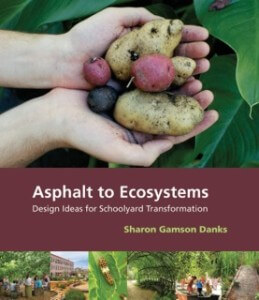 Environmental planner Sharon Gamson Danks is author of “
Environmental planner Sharon Gamson Danks is author of “
